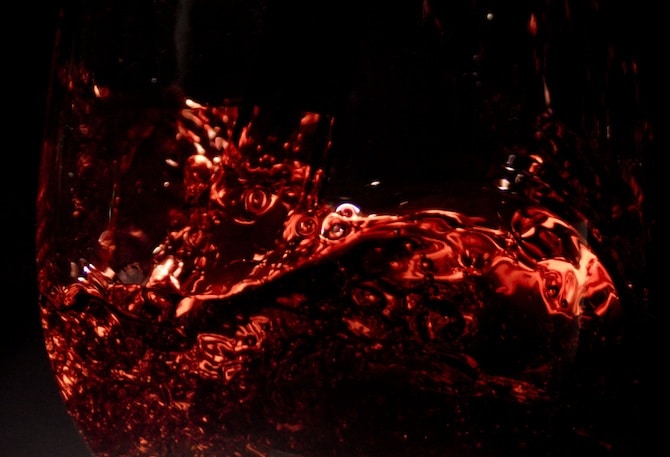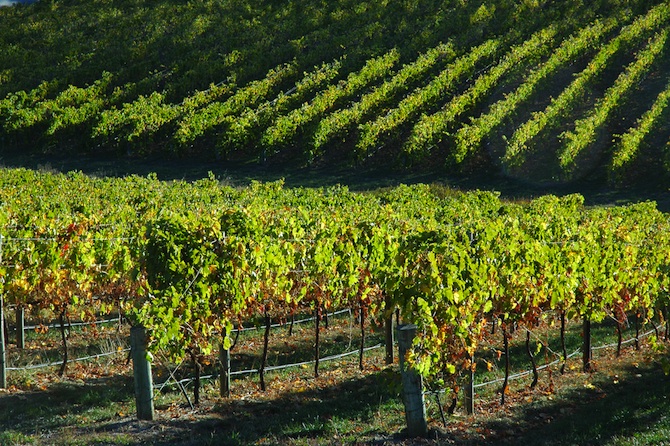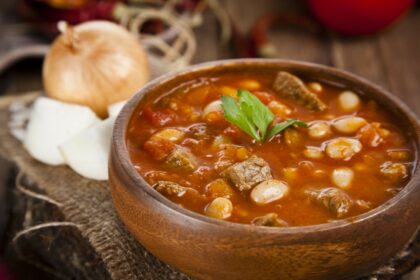
“By definition, what is the difference between Old and New World wines?”
Our instructor for today’s Sommelier Society of America certification course is Tad Drouet, a Certified Wine Educator (CWE) through the Society of Wine Educators. After talking extensively for the past five months about Old World wines, it’s finally time to get to the New World, specifically Southern Hemisphere wines. We begin with a discussion on New vs Old World to help us understand that wine styles vary — even when made by the same grapes — depending where you are.
By definition, when people refer to the Old World they mean Europe, while the New World is everything else. Typically, Old World wines are more regulated and strict in terms of production, and have higher acid, higher minerality, lower alcohol and are more focused on finesse and terroir. New World wines, on the other hand, tend to be the opposite, also with more fruit on the attack and oak.
Of course, this is a general guideline and not a hard rule, as modem technology, climate change and marketing needs are influencing wines today in different ways than they did in the past. There are now many reasons an Old World producer would make a New World-style wine. Not only is global warming causing grapes to ripen earlier, but people are wanting to drink their wines right after release instead of aging them. Moreover, markets like the US tend to drink wine without food, and fruitier, lower acid wines are easier to sip on their own. Then there’s the business of ratings, with New World wines tending to rate higher due to their approachability.
“Stylistically, the lines between New and Old World wines are blurring,” Mr. Drouet explains. “For example, you may have a New World producer trying to make a mineral-driven, high acid wine, or an Old World producer striving to make more approachable styles and garner high scores from critics.”
There are five main Southern Hemisphere regions we’ll be discussing during the tour-hour class, quite a lot to cover. Let’s begin.

South Africa
We begin with South Africa, the youngest region in the modern wine industry. Much of this is due to Apartheid, as during this time there was no investment in the industry and virtually no international export. Moreover, during this time other Southern Hemisphere regions were beginning to grow. Once Apartheid ended it wasn’t like the wine industry started booming right away. It took time for capital to start flowing in — which happened largely due to the positive influence of Nelson Mandela.
From the late 90s until now there’s been a big shift from cooperatives — the most well known of which is KWV, which once essentially controlled South Africa’s entire market — to more estates. Another change has been from sweet and fortified wines to dry wines. And while there was once more chenin blanc (aka steen) in South Africa than in the rest of the world combined, today many of these vines are being pulled up as the grape doesn’t really help the economy with its low pricing.
In South Africa there are three primary regions: Stellenbosch, known for its Bordeaux blends; Paarl, where you’ll find the above-mentioned KWV; and Constantia, well-known for sauvignon Blanc and having the best white wines in the country.
It’s also worth noting that despite syrah being the fastest growing grape in the country, pinotage is a focus grape of the country. The grape is a hybrid of pinot noir and cinsault, as growers wanted the characteristics of pinot noir — which is difficult to grow. That being said, it’s not the highest-quality grape, and you’ll rarely see a wine made with 100% pinotage.
For tastings, we first sampled a Simonsig Chenin Blanc (Steen) 2012 from Stellenbosch. This is not typically an aromatic grape, although I pick up slight aromas of honeydew and wet wool. There’s medium acidity with a slight honeyed taste, but it’s safe to say this is an easy quaffing wine that’s not particularly complex.
“If you’re tasting with a bunch of wine geeks throw in a South African red. It will really throw them off,” Mr. Drouet laughs. I can certainly see why with this next wine, a The William, Graham Beck 2009, a blend of 36% cabernet sauvignon, 44% syrah and 30% pinotage. It has a deep color with herbaceous notes, typical of Bordeaux blends in South Africa. With this wine there’s some hints of oak, with medium tannins and a striking acidity for red wine.
Visiting South Africa? We recommend spending time in the Durbanville Wine Valley.

Chile
The next region we visit in class is Chile, the first country in the Southern Hemisphere to break into the modern wine industry. Typically, Chilean wines are very entry level, costing about $7-$12 and are fruity and less oxidative in style. While Chilean producers have tried to break into higher price brackets, it’s just not happening yet.
Chile is know for Bordeaux blends, and their special grape is carmenere, which isn’t really grown elsewhere. The grape was brought over from Bordeaux and was originally thought to be merlot until a viticultural expert discovered this to be false. In terms of flavor profile, carmenere most closely matches cabernet franc due to its herbaceous quality, and can be very unpleasant if underripe (although it’s common to blend it with cabernet and Syrah to ripen it up).
Carmenere isn’t the only grape grown in Chile. The country is also known for its cabernet sauvignon, merlot, sauvignon blanc and chardonnay. While historically Chile had trouble growing white wines due to hot weather, in recent years winemakers have began moving toward the coast to reap the rewards of cooler climates.
If you’re going to comprehend one region for Chilean wine, it should be Maipo, located in the Central Valley. Here cabernet sauvignon is king (as well as cabernet blends). Home to rocky, well-drained soils and over 30,000 acres of vineyards — some reaching over 2,500 feet in elevation — you’ll find reds in different styles depending if they come from the Alto Maipo (bold yet elegant), Central Maipo (a little less finesse but still well-balanced) or Pacific Maipo (more acidity from coastal maritime influence).
Our Chile tasting includes a Echeverria Family Reserve (Cabernet Sauvignon) 2007. One sniff shows some development on the nose, as it’s not all primary fruits but has a raisinated quality. According to Mr. Drouet this is a perfect example of a Chilean cabernet sauvignon, a dry wine with notes of black cherry, black currant and cassis. There’s also some dustiness on the nose, which denotes time spent in oak. This is a bit confusing for me as I often associate oak with vanilla; however, with cabernet the oak provides essences of cedar and humidor.

Argentina
Next we move to nearby Argentina, renowned for its delicious malbec wines. Those who love these wines with their dark fruit flavors and sweet tobacco finish might be surprised to know the the grape actually originated in France — it’s still popular in Cahors AOC — and, according to Wine Folly, arrived in Argentina in 1868 when a French botanist planted it.
Mr. Drouet explains to the class how Argentinian wines typically offer value, as they’re easy drinking, good quality and inexpensive at about $8 to $12 on average. Along with malbec, torrontes is a popular grape for the country, grown there almost exclusively. The grape produces aromatic white wines, often with scents of orange blossom, honey and stone fruits that could lead you to believe the wine will be sweet, but is often dry to off-dry with a refreshing acidity.
So, why is it not as well-known as malbec? Most likely because it’s grown near the lesser-known Salta instead of the popular Mendoza. Of all Argentina’s wine regions, Mendoza is undoubtedly the most important. Sitting on the edge of the Andes Mountains, the region produces about 70% of Argentina’s wines. Embedded in rocky, sandy soils leading to hard-working vines, some of these vineyards reach as high as 3,900 feet above sea level, helping to cool down the generally hot climate and add a pleasing acidity to the grapes due to slower ripening.
Within Mendoza there are also subregions, the most important of which are Lujan de Cuyo, which is larger in size and produces a softer quality of wine and Valle de Uco, which is higher in altitude and offers more structured tannic wines.
For Argentina we sample a Torrontes “Crios” Susana Balbo 2013. Susana Balbo is one of the most famous winemakers in Argentina, and Crios is her label. The wine is extremely aromatic, with notes of honey and dried apricot as well as a pungent floral characteristic. It almost smells like muscat, and I expect the wine to be sweet; however, torrontes is only sweet if the label tells you it’s dessert style, which this does not.
Mr. Drouet chimes in after this tasting. “We should all by crystal clear on one thing: fruity does not equal sweet. Wait 10 to 15 seconds after you taste and see how the wine finishes. Residual sugar will stay on your palate, which is why dessert wines are always last in a tasting. Let the fruit flavors settle and then decide.”
We also try an Altocedro “Ano Cero” Malbec 2012. With malbec, the wild card is always the tannins, as whether they’re soft or not will depend on how it’s made. With this wine there are aromas of oak and even an alcohol sensation when sniffing. There’s no pronounced earthiness or minerality, and it’s very fruit forward, which is all stylistically characteristic of New World wines.

New Zealand
“Most of New Zealand isn’t planted with grapes,” explains Mr. Drouet, before laughing. “Have you seen the movie “Lord of the Rings?” While the village is fiction, those mountains are not.”
While you may not find vineyards planted all over New Zealand’s North and the South Islands — they produce less than 1% of the world’s wine — much of what they do make is high quality, especially in the popular Marlborough. It wasn’t until the mid-80s that people started noticing New Zealand wines, due to the racy sauvignon blancs coming out of the country.
According to Mr. Drouet, New Zealand, with its temperate, maritime climate, enjoys very little regulation, and often produces dry wines, with key grapes being sauvignon blanc, chardonnay, merlot and cabernet sauvignon. There’s even muller-thurgau — better known in Germany’s wine country — which was surprisingly once the country’s most popular grape, but is losing momentum as of late (especially with its neutral taste). Pinot noir and riesling are also on the rise. As the wine industry grows, New Zealand is putting out more diverse styles of wine, like Bordeaux blends and Old World-style sauvignon blancs.
Our New Zealand wine tasting is a Terra Sancta Mysterious Diggings Pinot Noir 2012 from the South Island’s Central Otago, where you’ll often get a combination of Old World meets New World. This wine has wild cherry aromas and ripe fruit on the palate with good acidity, medium tannins and a fairly light body. According to Mr. Drouet, this is a great example of a pinot noir from this region.

Australia
In Australia, blending is a key wine technique. In red blends, you’ll often find cabernet sauvignon added to provide tannic structure and ageability and shiraz for spice. Shiraz is often combined with viognier for aroma and texture, mourvedre for a savory touch, and grenache for juicy fruits. Typically you’ll find inexpensive wines that offer great value, made using modern techniques.
Interestingly, Australian wine became very popular in the late 1990s/early 2000s but is starting to taper out. I was surprised to hear this, as I personally love Australian shiraz — the grape the country is most known for. Shiraz does best in warmer climates, and does well in South Australia’s Barossa Valley and McLaren Vale. These wines are some of the darkest full-bodied reds out there, with black fruit flavors and a peppery finish.
While shiraz is what Australia is most known for, it isn’t the only grape the country grows. Others to know include cabrnet sauvignon in the Coonawarra and Margaret River, merlot and pinot noir in the Yarra Valley, chardonnay and semillon in the Hunter Valley, and riesling in the Clare Valley and Eden Valley. As you can probably tell, Australia is very diverse in terms of what it produces, with a number of wine regions each known for something different.
That being said, there is a special wine style in Australia worth mentioning: dry semillon. While semillon is well known for its ability to stand up to botrytis and create sweet wines — like those found in Bordeaux’ Sauternes — in Australia (as well as a few other places) they create a dry version, mainly in the Hunter Valley. Making this style of wine is no easy task as the conditions must be just right, with the end result being something similar to a dry riesling, with lemon and citrus notes.
We begin this portion of the tasting in South Australia with a Henry’s Drive “Dead Letter Office” Shiraz 2009, a fruit forward wine with a distinct spicy component. This probably means the grapes were grown on old vines, as these offer more concentrated spice, as Mr. Drouet explains. Medium tannins and an acidity to match make this one of my favorite wines in the tasting.
We then sample a dry Torbreck Woodcutter’s Semillon 2011. Delicious aromas of apple, pear and lemon fill my nose, while the medium body, refreshing acidity and medium-long finish are nothing like the semillons I’ve tried from Sauternes — but still very enjoyable.
The best way to get to know Southern Hemisphere wines? Travel to these diverse regions and try them for yourself.
This article is part of an Epicure & Culture original series, Sommelier Certification.
Have you explored any of these Southern Hemisphere wine regions? Please share in the comments below.
Also Check Out:
How To Create Your Own Online Magazine
Unique Winemaking Experiences In South Australia’s Barossa Valley
Epicurious Adelaide Hills: Skordalia, Chèvre And Cool Climate Wines At Lobethal Road
Jessica Festa
Latest posts by Jessica Festa (see all)
- A Culturally-Immersive Adventure In Mongolia’s Altai Mountains - Jul 8, 2023
- This Recipe Sharing Platform Supports Women In The Culinary Industry (Labneh Recipe Included!) - Nov 5, 2020
- Hiking The Mohare Danda Community Eco-Trek In Nepal - Jun 3, 2020
- 6 Important Questions For Choosing A Responsible Yoga Retreat - May 18, 2020
- How To Create & Grow A Profitable Blogging Business (Ethically) - Jan 18, 2020




